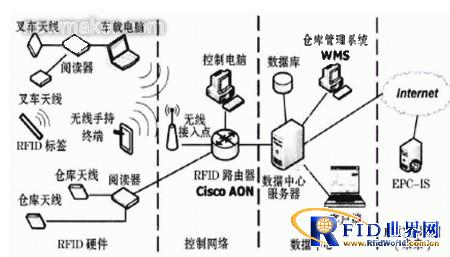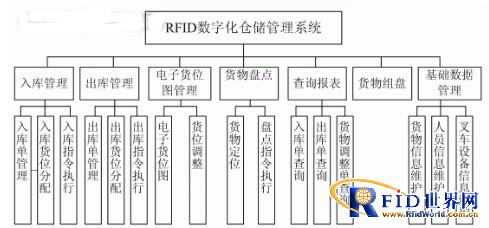I. Introduction
Warehousing plays a role in buffering, regulating and balancing in the logistics system. It is one of the central links of logistics, and it is also the premise and guarantee of distribution. In the design process of the warehouse management system, the primary consideration is the timeliness of entering and leaving the warehouse, which will directly affect the integration and throughput of the warehouse, and the integration and throughput capacity are related to the economic benefits of the warehouse. However, in the past manual management system, the problem of inefficient cargo location and manual check has long plagued warehouse managers. With the development of computer technology, the above problems can be solved well by introducing the warehouse positioning system and the rfid system.
In the warehouse positioning system. The GIS system is used to manage the cargo space, including cargo location inquiry, cargo space allocation, and cargo space utilization thematic map analysis. RFID (Radio Frequency Identification) radio frequency identification technology has gained more and more attention in the logistics and warehousing industry due to its advantages of non-contact, reusable, fast scanning, convenient and quick acquisition, large data capacity and long service life. Introduce RFID technology and GIS technology into the warehouse management information system to realize the first-in-first-out of goods, electronic cargo space management, operation process monitoring and management, so as to maximize the efficiency of warehouse management information system on the basis of digitization and informationization, and to warehousing Perform refined management.
Second, system function and structure design
The core of the RFID-based warehouse management system is that each item is tagged with an RFID tag, and an RFID reader is placed at the entrance of each entrance of the warehouse. When the item is passed through the reader, the reader can obtain the information of the goods through the transponder on the goods. A number of RFID handheld terminals or wireless in-vehicle data terminals are also installed in the middle and outbound channels of each shelf in the library. In order to track the information of the goods in the warehouse and the information when the goods are out of the warehouse, the accurate automatic input of the information in the warehouse management can be realized, the data of each operation link of the warehouse can be automatically collected and the data input speed of each link of the warehouse management can be guaranteed. And accuracy. Ensure timely and accurate grasp of the real data of the inventory, reasonable maintenance and control of warehouse inventory. Combined with GIS technology, it can accurately locate goods or cargo spaces, reduce the time of outbound, warehousing, inquiry and inventory, and improve the efficiency of storage operations.
The system consists of two parts: hardware equipment and software function modules. The main idea is to realize the combination of one-dimensional barcode and RFID in the warehouse management information system. Tray-mounted RFID electronic tags, using RFID electronic tags, repeated use, large data capacity, no need for manual intervention, etc., to improve the level of warehouse automation and achieve pallet-based storage: goods one-dimensional bar code, using one-dimensional bar code cost Significantly lower than the advantages of RFID tags to reduce costs, cargo-based zero-storage and cargo tracking. One-dimensional barcode and RFID are combined. Not only can you obtain precise control over warehouse data information, but it can also reduce the cost of system implementation.
1 system hardware composition
The architecture of the RFID-based serialized warehouse management system determines that the system should have at least the following hardware devices.

(1) The main control system. Including the main control computer, the RFID reader of the outbound/inbound port, the group panel RFID reader and so on. The main control computer is connected to the RFID reader of the outbound/outbound port, the group panel RFID reader and the server through a data line or a wireless network.
(2) Server. The server is connected to the main control unit and the forklift via a wireless network connector.
(3) Forklift and car tablet: The forklift navigation subsystem is installed on the car tablet for cargo navigation. The car navigation system is connected to the server via a wireless network.
(4) Handheld unit. Includes 1D barcode scanner and mobile RFID reader. The one-dimensional barcode scanner is used to read the one-dimensional barcode of the cargo and is connected to the host computer through a wired (or wireless) network. The mobile RFID reader is used to read the tray RFID tag information for inventory counting.
2 system software function module composition
The RFID-based digital warehouse management system functions to extend and extend the functions of the traditional warehouse management system, including the following functions: inbound management, electronic cargo management, outbound management, and cargo assembly.

The overall structure of the system (1) storage management. Realize the goods storage operation. The entry, modification and deletion of the warehousing documents can be completed, and the inbound storage spaces are automatically allocated and manually allocated. A job such as a delivery document order is sent.
(2) Outbound management. Similar to inbound management. Realize the goods out of the warehouse operation. It can complete the entry, modification, deletion of the outbound document, automatic allocation of the outbound storage position, manual allocation, and assignment of the assigned position document instruction.
(3) Electronic cargo map management. It is mainly used to query and display the storage location of the warehouse and to visualize the position adjustment operation, including the timely display of the inventory information of the warehouse area, the inquiry and adjustment of the inventory address of the goods (tray).
(4) Enquiries and statements. The warehouse administrator manages the inventory status, documents, and goods and location status in the system database through queries and reports. These include: location adjustment order inquiry, outbound order inquiry, inbound order inquiry, and so on.
(5) Goods inventory. The goods in the warehouse should be regularly and irregularly counted; the information in the database should be modified in time. Avoid omissions and errors.
(6) Basic data maintenance. View, add, delete, and modify information such as goods, personnel, and forklifts in this system to facilitate the use of data in other functions.
(7) Cargo group. Realize the location of the goods, the tray tray operation. The warehouse management information system supports non-integrated tray entry and exit, so the inbound/outbound operations require the group disk function module to realize the operations of entering the library disk and releasing the library. The group disk function module mainly realizes the functions of reading and writing tray RFID tag information (mainly one-dimensional bar code information), tray cargo increase/decrease, and group disk undoing.
Figure 2 System main function module Figure 3, summary
The digital warehousing management system based on RFID technology fundamentally guarantees the accurate unification of warehousing information. Improve the efficiency of warehousing operations and management, and greatly reduce the time to find and locate cargo and cargo information in the existing model. Greatly speed up the flow of the outbound and inbound orders. Enhanced processing power of the warehouse system. And improve the utilization of people and equipment. Reduce unnecessary costs and reduce logistics costs. Therefore, the RFID-based warehouse management system can meet the needs of the warehouse management system under the modern logistics management mode.
This category is a series of outdoor furniture, our products are of high quality, easy to carry, available in a variety of sizes, with adjustable structures to provide you with a good experience.We provide product pictures and basic parameters of each outdoor furniture and high-quality outdoor furnitures.Look forward to your cooperation!
outdoor furniture bench,outdoor furniture chairs,patio chairs,outdoor patio furniture,outdoor furniture cover
Ningbo Autrends International Trade Co., Ltd. , https://www.outerlead.com